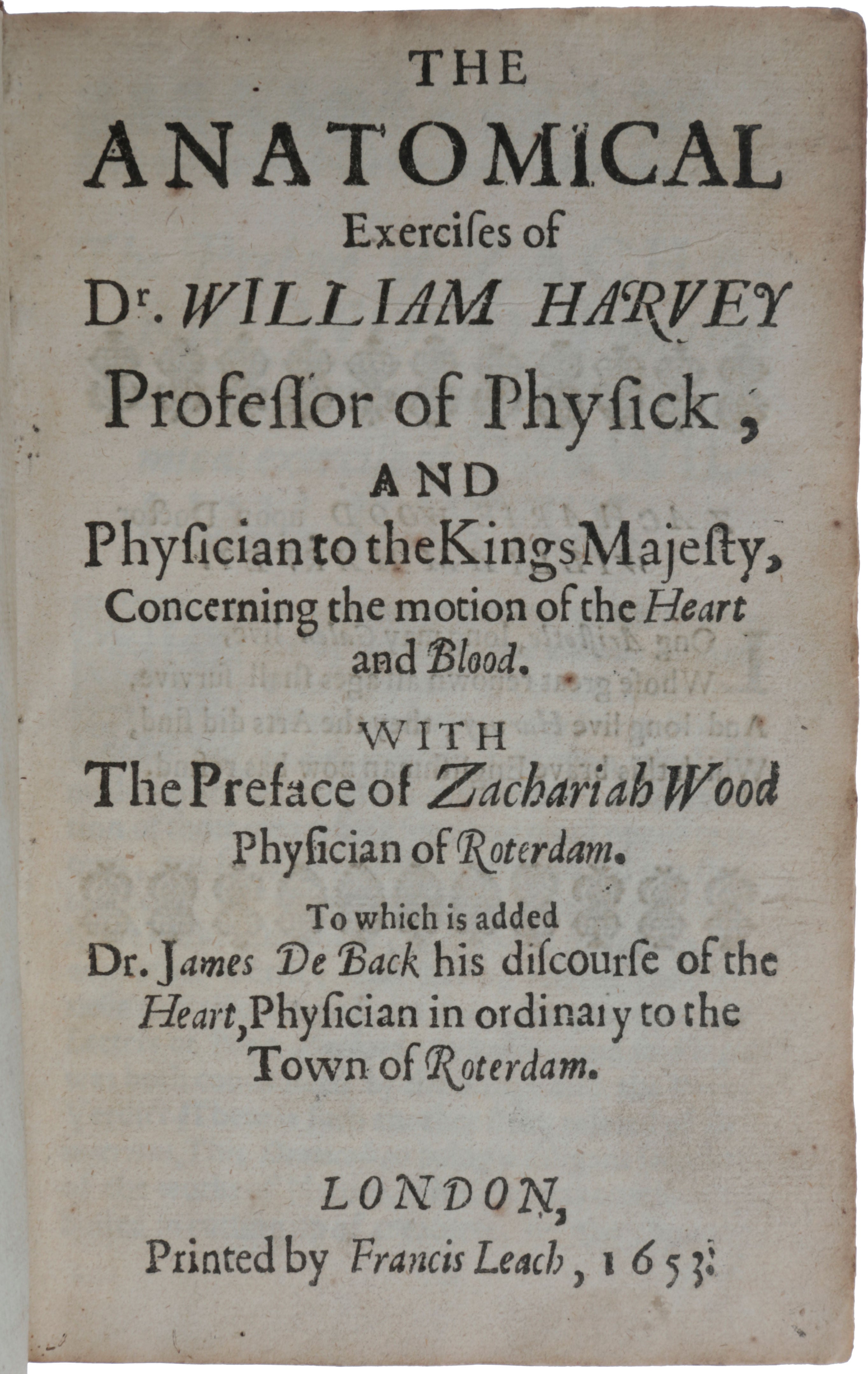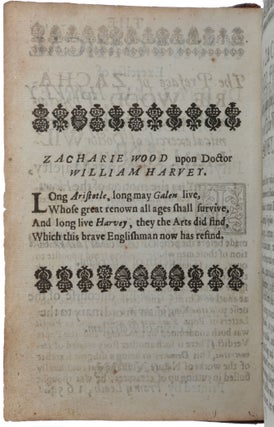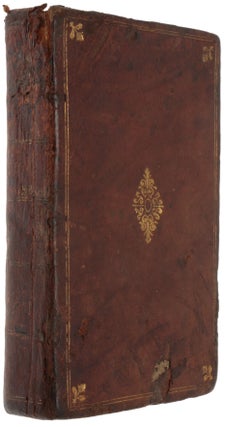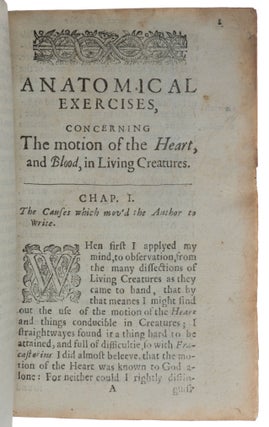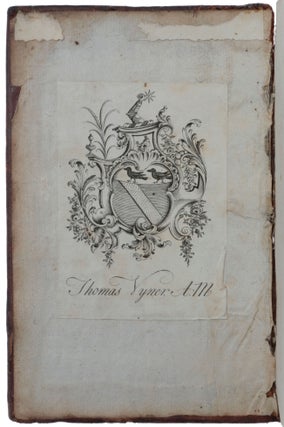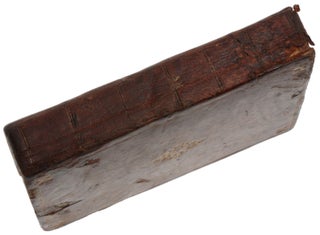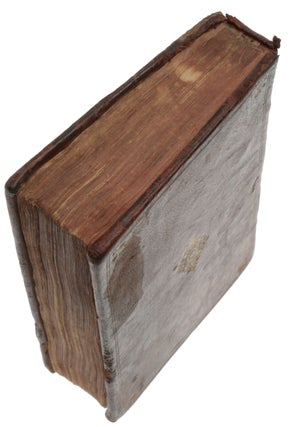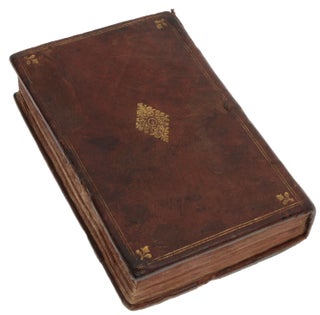The Anatomical Exercises of Dr. William Harvey, Professor of Physick, and Physician to the Kings Majesty, Concerning the motion of the Heart and Blood. With the preface of Zachariah Wood Physician of Roterdam. To which is added Dr. James De Back his discourse of the Heart, Physician in ordinary to the Town of Roterdam.
London: Printed by Francis Leach, 1653. First edition in English of De motu cordis (1628), in which was described the discovery and proof of the circulation of the blood; this is the very rare first issue with uncancelled title and this leaf unclipped by the printer (see below). Harvey’s discovery and experimental proof of the circulation of the blood created a revolution in physiology comparable to the Copernican revolution in astronomy: it was to become “the cornerstone of modern physiology and medicine” (Garrison-Morton). De motu cordis “is probably the most important book in the history of medicine. What Vesalius was to anatomy, Harvey was to physiology; the whole scientific outlook on the human body was transformed, and behind almost every important medical advance in modern times lies the work of Harvey” (Heirs of Hippocrates). It should also be regarded as “the first record of a complete biological investigation, giving a clear and accurate description of the methods employed to recognise the laws governing an important vital process, a knowledge of which had till then been befogged by mistaken conceptions” (H.P. Bayon in Keynes). This first English edition is, according to Keynes, translated from the Rotterdam edition (1648), and like that edition includes (in translation) the additional commentaries by Zachariah Wood, James De Back’s Dissertatio de corde (first published in Latin at Rotterdam in 1648), and Harvey’s own Exercitatio anatomica de circulatione sanguinis (first published in Latin at Cambridge in 1649), consisting of two essays addressed to Jean Riolan, the younger, in response to Riolan’s Encheridium anatomicum, et pathologicum (1648). “Riolan admitted that some vivisectional evidence seems to support the general, rapid Harveian circulation; but he maintained that under normal physiological conditions the movements of the blood are much more tranquil than those observed in vivisection” (DSB). In his reply, Harvey provided further experimental proof of the circulation of the blood. “In [De circulatione sanguinis] Harvey first described the circulation of blood through the coronary arteries. Harvey also described experiments that he made to provide further support to his theory of the circulation. Published simultaneously by Daniel in Cambridge and Arnold Leers in Rotterdam” (Garrison-Morton). More recently, however, John Stuart White has argued forcefully that this English edition is not, in fact, a translation at all but is actually a printed version of Harvey’s original manuscript of De motu cordis which, he maintains, was first written in English and then translated by Harvey into Latin. This is course adds a great deal of interest to this edition. Almost all copies of this edition are of the second issue with a cancel title. In the only copies of the first issue seen by Keynes a triangular piece had been clipped from the bottom outer corner of the title – directing the binder to replace it with the new title –with the consequent removal of the date of publication: Keynes's dating of the first issue is therefore conjectural, expressed as [?1653]. The pagination errors noted by Keynes are present in this copy, but with the following differences: in the first part page 5 is correctly printed, the numerals for pages 9 and 44 are inverted and page 46 is printed as 64; in the second part, page 105 is printed as 015; in the third, the numbering for pages 12 and 13 is transposed. No copies of this first issue listed on ABPC/RBH. Provenance: Thomas Vyner (d. 1673) of Eathorpe Hall, Warwickshire (eighteenth-century bookplate). He was educated at St. Catherine’s College, Cambridge, and awarded the BA in 1650, MA in 1653, BD in 1662 and DD in 1671. Small marginal note in a seventeenth-century hand on one leaf. “William Harvey was born in Folkestone, Kent in 1578; he was schooled at King’s School Canterbury then Gonville and Cauius College Cambridge. However, arguably it was his subsequent medical schooling at Padua, and resultant exposure to the anatomical research and methods of his Paduan predecessor Vesalius and his teacher Fabricius, that was most instrumental in his medical development. The University of Padua was a popular destination for many English medical students at the turn of the seventeenth century owing to its esteemed teaching staff and improved opportunity, in comparison with Oxford and Cambridge, for taking part in anatomical dissection. However, not all anatomy instruction at Padua followed the same approach. Vesalius had advocated a very novel empirical model urging students to become involved in dissection and ‘feel with [their] own hands and trust them’. Conversely, Harvey’s tutor Fabricius taught anatomy from an Aristotelian natural philosophical standpoint rather than a structural one - so advocated a less ‘hands-on’ approach, discouraging direct participation. Consequently Harvey was educated in an environment where there was a tension between describing anatomy structurally, using an empirical approach, and teaching anatomy from a broader Aristotelian philosophical standpoint, explaining units of anatomy in isolation. Arguably this legacy of two alternative approaches can be seen in De motu cordis. While in practice, Harvey carried out experiments on the heart, taking measurements and ‘feel[ing] with his own hands’ in the Vesalian tradition, he remained very deferential towards the ideas of Galen and particularly Aristotle throughout - even describing his enquiry as philosophical rather than medical” (Glasgow University Library Special Collections Department Book of the Month, June 2007). “Galen had regarded the veins as serving to convey to all parts of the body the nourishing blood elaborated in the liver. He recognized that both veins and arteries contained blood, and assumed that the arterial blood — clearly differentiable from the venous blood by its colour — was replenished where necessary from the venous supply through the septum of the heart. Sixteenth-century anatomists like Vesalius recognized that the septum was solid. The earliest published reference to the pulmonary or lesser circulation — passage of the blood from the right to the left side of the heart through the lungs — is in Servetus’s theological treatise of I553, but as this was virtually unknown to medical men, the first real public enunciation must be regarded as the clear statement by Realdus Columbus in De Re Anatomica (1559). In I603 Harvey’s teacher, Fabricius of Aquapendente, published a monograph on the valves in the veins — previously noted by others — the purpose of which he only partially understood. “It was left for Harvey to combine these discoveries, to conceive the idea of a circulation of the entire blood system, and demonstrate it conclusively by an exhaustive series of dissections and physiological experiments. For twenty years Harvey pursued his objective in both human and comparative anatomy. He proved experimentally that the blood’s motion is continuous and always in one direction, and that its actual amount and velocity makes it a physical impossibility for it to do otherwise than return to the heart by the venous route, the heart being itself a muscle and acting as a pump. He showed how the whole of the blood passes through the lungs, is returned to the left side of the heart, then passes through the general circulation and returns to the right side; he even suspected the existence of the capillaries connecting the smallest arteries with the smallest veins, but without the microscope he could not see them. They were discovered in 1661 by Malpighi.
The arguments and demonstrations marshaled by Harvey were too cogent to admit of long resistance, and his work was accepted by medical men in his lifetime. Descartes used the discovery as a basis for his mechanistic physiology; English experimental scientists regarded the discovery as of equal importance with Copernican astronomy or Galilean physics; Lower supplemented Harvey’s work by discovering the role of the lungs in supplying the arterial blood with air. With all this, Harvey’s work did not effect any change in medical practice nor fundamentally alter contemporary views on physiology” (PMM). “Downgrading the role of the heart from a vital organ directly involved in personality, psyche and spirituality to a mere pump had many implications. The investigation into the role of the heart within the body took place during a period where significant political and constitutional debates were taking place. The de-mystification of the heart re-enforced challenges to other received "truths" - such as Charles I's divine right to rule England. Furthermore, Harvey provided ammunition to the new breed of philosophers rejecting Aristotelian ideas. René Descartes (1596-1650) quickly adopted and championed Harvey’s idea of circulation seeing it as a neat way of removing the soul from the equation and so creating a purely mechanical explanation of the body. “Perhaps the most lasting influence, however, was brought about due to Harvey's scientific method. De motu cordis was often described as the very epitome of Baconian methodology. While commentators such as Walter Pagel have shown that Harvey was, in fact, very conservative, owing many of his circulatory ideas to traditional Aristotelian thought, De motu cordis quickly became understood as a rejection of traditional methods. It was viewed as challenging the traditional system of deductive reasoning via syllogisms, instead advocating experimentation and sensory experience. The empirical methodology observable in Harvey’s work is now the acknowledged scientific method and has been universally adopted across all science and medicine” (Glasgow University Library Special Collections Department Book of the Month, June 2007). “The two treatises which form De circulatione sanguinis have for too long been considered as merely an appendix to De motu cordis. They are far more important than that. The First Letter is a direct criticism of Encheridium. It is not a general discussion of the circulation but treats only the points raised by Riolan. The greater part of the Second Letter is a restatement of Harvey’s hypothesis concerning the circulation of the blood supported by further experimental proof, and for this reason it is different in character from the first. It is concerned to affirm a truth and prove its validity by arguments drawn from experimental evidence not, as in the case of the First Letter, to deny a falsity. The argument is not as tightly worked out as in De motu cordis but weaves around the theme of the movement of the blood in the arteries and veins and its immediate cause and manner. The points discussed are chosen to answer specific criticisms or to refute alternative notions” (Keynes, pp. 73-74). The appreciation of this work has grown during the 20th and 21st centuries because it describes for the first time the circulation of blood through the coronary arteries. Harvey’s discovery of the coronary circulation is a milestone, especially in view of the growing significance in recent times of coronary artery disease. “Harvey’s writings were directed solely to the world of science, so that it is not remarkable that they were for long allowed to keep the decent cloak of Latin in which they had first appeared. In 1653, however, when Harvey was old and tired, the two treatises were translated into English and published by Richard Lowndes in London. The writer of the translation remain anonymous. It is unlikely that Harvey himself had any hand in making it but there is no reason for supposing that he disapproved of the undertaking. The first Latin addition of 1628 had been very inaccurately printed and later editions repeated many of its mistakes. The translator of 1653 also allowed himself to take liberties in doing his work and either he or his printer allowed words and even whole sentences to drop right out of the text … The original Latin edition of 1628 was adorned with two engraved plates illustrating a series of remarks in the text on the function of the valves in veins … Unaccountably they were omitted altogether from the English editions of 1653 and 1673, although the references to them were allowed to remain in the text” (Keynes, Postscript to The Anatomical Exercises: De Motu Cordis and De Circulatione Sanguinis in English Translation, 2013). White, on the other hand, comes to the following conclusion from a comparison of the 1628 Latin and 1653 English editions. “From the comparison of text it will be shown that unequivocal examples of diversity exist between words used in the Latin and English editions of De motu cordis which cannot be attributed to translation error but is consistent with Harvey’s use of similar terms in the vernacular that have been identified from his lecture notes … Conceptual differences and changes in nomenclature in the English text will show that they occurred either because of the development of Harvey’s ideas or simply the passage of time between writing the first section of De motu cordis and completion of the book sometime after 1625. For this evidence to persist in the English text it must have been the original language in which De motu cordis was written” (White, pp. 65-66). Keynes 19; Osler 714; Cushing H137; Norman1008; Heirs of Hippocrates 422; Waller 4105; NLM (17th C.) 5338; Wellcome III.219; Wing H1083. For the first edition: PMM 127; G&M 759; Grolier Science 46; Grolier Medicine 27a; Heralds of Science 123 (also noting first English); G&M 759. White, ‘The 1653 English edition of De motu cordis, shown to be Harvey’s vernacular original and revealing crucial aspects of his pre-circulation theory and its connection to the discovery of the circulation of the blood. History and Philosophy of the Life Sciences 21 (1999), pp. 65-91.
Three parts on one vol., small 8vo (151 x 96 mmmm), pp. [xl] (including the initial blank), 112, [xx], 86, including divisional titles to the last two parts (a few slight stains, one page a little smudged in the printing, some trifling worm traces in a few margins, small original marginal defects in a few leaves). Contemporary calf, double gilt rule borders on the sides with central gilt lozenge ornament and floral corner-pieces, spine panelled with gilt rules, red edges (scrape at foot of front board with a little loss, spine a little deficient at head of front joint). A large, clean, and crisp copy with no cropping of the headlines seen in many copies.
Item #5638
Price: $125,000.00

